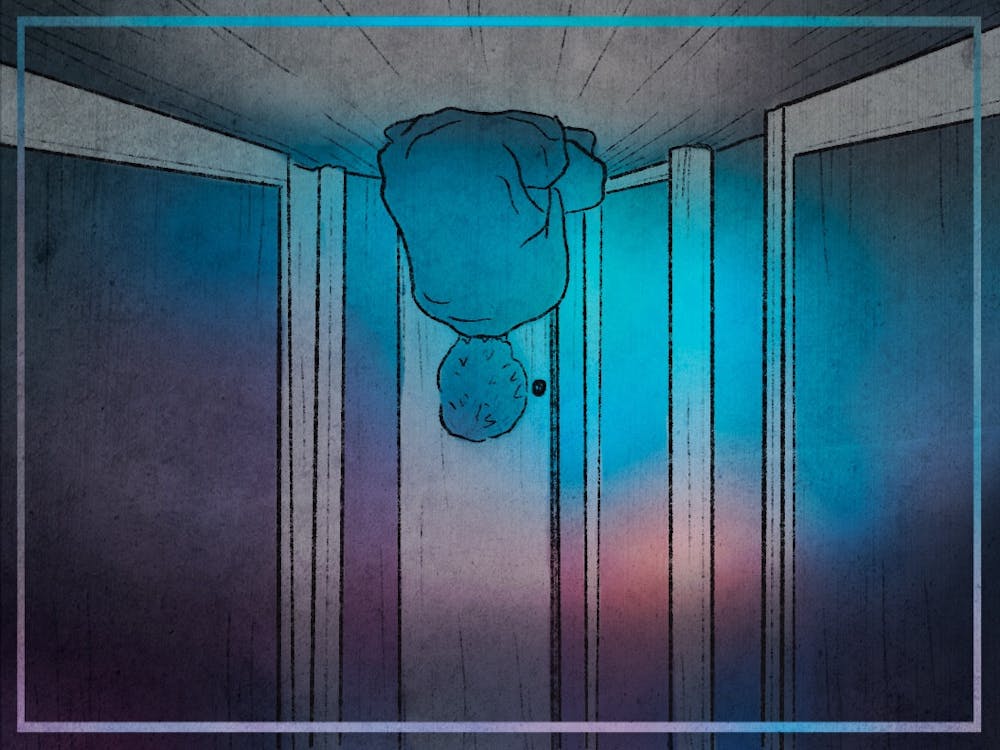Spoilers follow for the film “Skinamarink.”
In this house toys scatter the floor, cartoons play nonstop, parents are nowhere to be found, children are left to fend for themselves — and so was I.
Canadian director Kyle Edward Ball’s “Skinamarink” premiered at the 26th Fantasia Film Festival in Montreal July 25 before reaching U.S. theaters Jan. 13. It will be available to stream on Shudder starting Thursday.
Ball’s debut feature-length film took low budget to the extreme. “Skinamarink” turned a budget of $15,000 into more than $1.5 million in earnings at the box office.
“Skinamarink” centers on a pair of children, Kevin and Kaylee, who wake up to find their father missing while the doors and windows in the house disappear. The innovative concept on its own was enough for me to put the miniscule budget aside and go see the movie.
However, the style is what sets it apart from other small-scale horror films.
“Skinamarink” is easily compared to “The Blair Witch Project” and “Paranormal Activity,” but its build up, satisfying scares and strong themes put the movie in a league of its own by the end of its 100-minute runtime.
“Skinamarink” is the definition of experimental. It’s composed almost entirely of high- and low-angle shots, aimed up at the ceiling or down at the floor. And it’s nearly impossible to see the face of any of the characters.
Rather than relying on its characters, “Skinamarink” thrives in its immersion. Sound design, cinematography and lighting work together to build the film to a perfectly unbearable level.
The film goes from being dead silent to overwhelmingly loud in a split second. Outside of the occasional line of dialogue or eerie sound effect, the movie’s silence holds still as tension builds higher than seemingly possible.
The audio is unrelenting, but the visual horror might exceed it.
The cinematography and lighting placed me firmly in the shoes of the children onscreen, complementing the already immersive sound design. The lighting creates the feeling of a lurking presence; the cinematography forced me to confront it.
“Skinamarink” is a very dark film, in terms of content and lighting. The background is rarely in full view, and even the foreground is hard to make out at times.
The high- and low-angle shots allow the action to be seen but not the being behind it. When a door opens, it could be one of the children, or it could be the sinister presence.
But you can’t hide forever.
When “Skinamarink'' puts the horror on screen, it’s impossible to avoid. Despite watching through my fingers, I saw everything. I felt like I couldn’t look at the screen, but I kept going back for more.
The film’s point-of-view shots were the perfect change of pace compared to its unconventional, still shots. Specifically, the movie’s look-under-the-bed scene showed exactly what the child would have seen as she checked under the bed.
“Skinamarink” avoids the typical ghost story and used my childhood fears to get under my skin.
Children are afraid of the dark. They’re scared to look under their bed. And they fear being alone without their parents. “Skinamarink” does exactly this, and it shows how these ideas are connected.
The film shows what happens in the absence of parents, tackling grief and abandonment at the same time. When the mother and father leave the film, the children are left to deal with an ominous presence alone.
The daughter, Kaylee, was present when her parents vanished, but she was instructed to close her eyes as it happened. However, she has her eyes and mouth taken from her. This shows her losing her way and becoming a new person after her parents left.
Kevin, the boy, faces a different fate. Kaylee didn’t do as the ominous voice instructed. She asked for her parents and couldn’t accept the fact that they were gone. Kevin saw what happened to her and learned from her mistake.
A face sits in the dark and instructs Kevin to go to sleep. He asks the figure's name but gets no answer.
“Skinamarink” shows what happens when a child is abandoned. The last time a boy named Kevin was left home alone, his family came back to him on Christmas day. Kevin’s parents were gone this time.
Kevin’s toys vanished into the distance. His world, and home, flipped upside down.
But instead of his parents’ absence breaking him, he confronted his fear and accepted his reality. He needs to grow up and leave his childhood behind — a sad but important realization.
Children are abandoned, forced to grow up sooner than most and faced with their fear of the dark in this house.
Rate: 9/10
Contact Kyle Bumpers at kbumpers@alligator.org. Follow him on Twitter @BumpersKyle.
Kyle Bumpers is a fourth-year journalism major and the sports editor of The Alligator. In his free time, he cries about Russell Wilson and writes an outrageous amount of movie reviews on Letterboxd.






